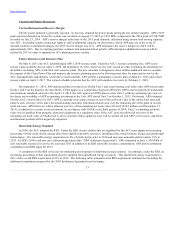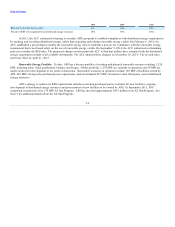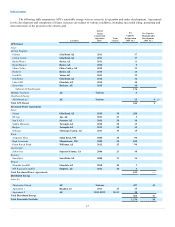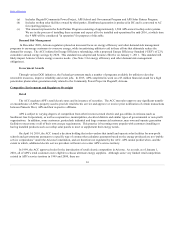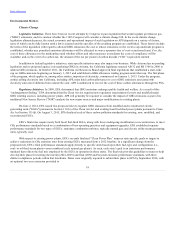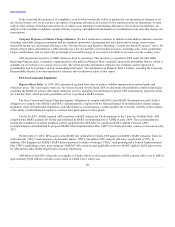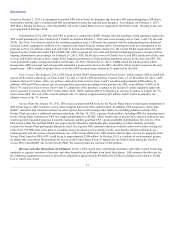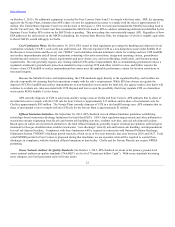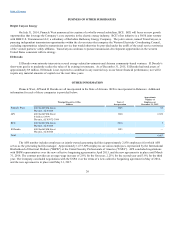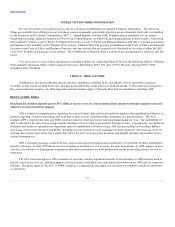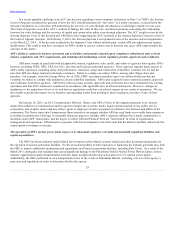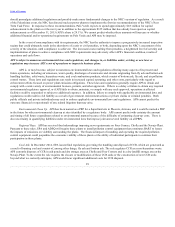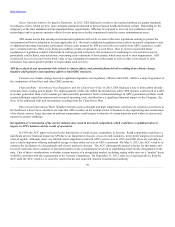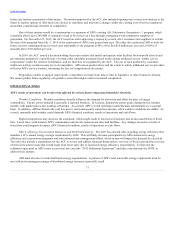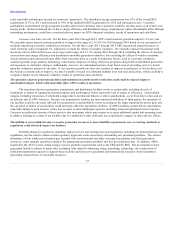APS 2015 Annual Report Download - page 26
Download and view the complete annual report
Please find page 26 of the 2015 APS annual report below. You can navigate through the pages in the report by either clicking on the pages listed below, or by using the keyword search tool below to find specific information within the annual report.
Table of Contents
increasing pressure to reduce emissions of nitrogen oxides and volatile organic compounds, and to generate emission offsets for new
projects or facility expansions located in ozone nonattainment areas. EPA is expected to designate attainment and nonattainment areas
relative to the new 70 ppb standard by October 1, 2017. Depending on when EPA approves attainment designations for the Arizona
and Navajo Nation jurisdictions in which our fossil generation units are located, revisions to SIPs and FIPs, respectively, implementing
required controls to achieve the new 70 ppb standard are expected to be in place between 2020 and 2021. At this time, because
proposed SIPs and FIPs implementing the revised ozone NAAQSs have yet to be released, APS is unable to predict what impact the
adoption of these standards may have on the Company. APS will continue to monitor these standards as they are implemented within
the jurisdictions affecting APS.
Clean Air Act Citizen Lawsuit. On October 4, 2011, Earthjustice, on behalf of several environmental organizations, filed a
lawsuit in the United States District Court for the District of New Mexico against APS and the other Four Corners participants alleging
violations of the NSR provisions of the Clean Air Act. Subsequent to filing its original Complaint, on January 6, 2012, Earthjustice
filed a First Amended Complaint adding claims for violations of the Clean Air Act’s New Source Performance Standards ("NSPS")
program. The case was held in abeyance while APS negotiated a settlement with DOJ and environmental plaintiffs. In March 2015, the
parties agreed in principle to settle the case, and on June 24, 2015, DOJ lodged the proposed consent decree with the United States
District Court for the District of New Mexico. On August 17, 2015, the consent decree was entered by the district court.
The settlement requires installation of pollution control technology and implementation of other measures to reduce sulfur
dioxide and nitrogen oxide emissions from the two Four Corners units, although installation of much of this equipment was already
planned in order to comply with EPA's Regional Haze Rule requirements. The settlement also requires the Four Corners co-owners to
pay a civil penalty of $1.5 million and spend $6.7 million for certain environmental mitigation projects to benefit the Navajo Nation.
APS is responsible for 15 percent of these costs based on its ownership interest in the units at the time of the alleged violations, which
does not result in a material impact on our financial position, results of operations or cash flows.
Superfund-Related Matters. The Comprehensive Environmental Response Compensation and Liability Act ("Superfund")
establishes liability for the cleanup of hazardous substances found contaminating the soil, water or air. Those who generated,
transported or disposed of hazardous substances at a contaminated site are among those who are potentially responsible parties
("PRPs"). PRPs may be strictly, and often are jointly and severally, liable for clean-up. On September 3, 2003, EPA advised APS that
EPA considers APS to be a PRP in the Motorola 52nd Street Superfund Site, Operable Unit 3 ("OU3") in Phoenix, Arizona. APS has
facilities that are within this Superfund site. APS and Pinnacle West have agreed with EPA to perform certain investigative activities of
the APS facilities within OU3. In addition, on September 23, 2009, APS agreed with EPA and one other PRP to voluntarily assist with
the funding and management of the site-wide groundwater remedial investigation and feasibility study work plan. We estimate that our
costs related to this investigation and study will be approximately $2 million. We anticipate incurring additional expenditures in the
future, but because the overall investigation is not complete and ultimate remediation requirements are not yet finalized, at the present
time expenditures related to this matter cannot be reasonably estimated.
On August 6, 2013, the Roosevelt Irrigation District ("RID") filed a lawsuit in Arizona District Court against APS and 24 other
defendants, alleging that RID’s groundwater wells were contaminated by the release of hazardous substances from facilities owned or
operated by the defendants. The lawsuit also alleges that, under Superfund laws, the defendants are jointly and severally liable to RID.
The allegations against APS arise out of APS’s current and former ownership of facilities in and around OU3. As part of a state
governmental investigation into groundwater contamination in this area, on January 25, 2015, ADEQ sent a letter to APS seeking
information concerning the degree to which, if any, APS’s current and former ownership of these
23


